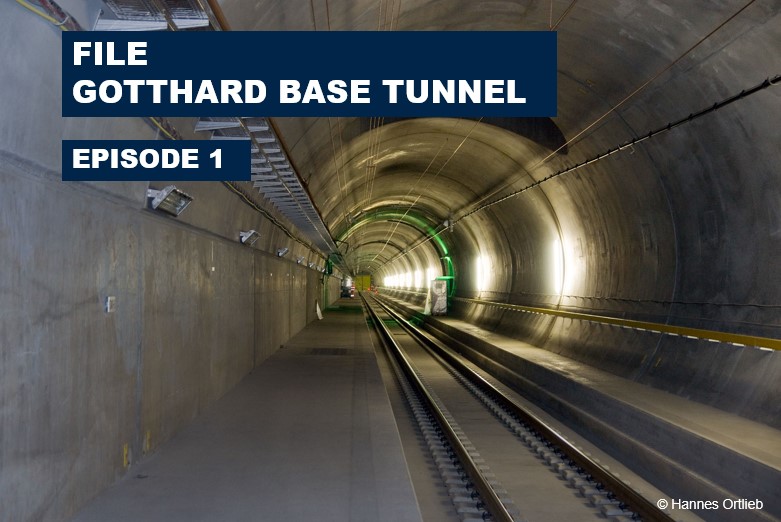On 10 August 2023, a freight train derailed in the Gotthard Base Tunnel. The Swiss Transportation Safety Investigation Board (Sust) believes the likely cause was the failure of a wheel. We at VAP will investigate the event systematically from a risk-oriented perspective.
Topics discussed:
- Emergency concept functioning, supply ensured
- Proven responsibility triangle
- Safety standards complied with
- Legal relationships comprehensively regulated
- Breakages are rare but cannot be ruled out
- Continued pursuit of the modal shift goal
Emergency concepts functioning
Thanks to further improvements to emergency concepts, the key actors responded quickly and appropriately after the accident: The supply of goods is secured, freight and passenger rail cars are on the move again. The emergency concepts of the freight railway undertakings for routing detour traffic along the transit corridor have proven themselves. The lessons from Rastatt have been learned, the industry is prepared for emergencies.
Proven responsibility triangle
The rail freight system is based on cooperation carried out on equal footing between infrastructure providers (for the Gotthard Base Tunnel: SBB) and freight railway undertakings as well as other actors such as wagon keepers, who potentially influence the safe operation of the railway system. All involved have advanced safety systems and implement the same European regulations at the interfaces between the various actors.
Safety standards complied with
According to current information, all actors complied with the applicable safety standards and methods. The last inspection for trains driving through the south portal into the Gotthard Base Tunnel takes place at Claro (TI) by automatic wayside train monitoring systems. According to the available data, the derailed train travelled into the tunnel without problems. The wagon keepers and their entities in charge of maintenance (ECMs) are responsible for the maintenance and safe operating condition of the wagons upon handover to the freight railway undertakings. The ECM, which is certified by independent bodies, defines maintenance measures and ensures their implementation and documentation according to safety standards and methods.
Legal relationships comprehensively regulated
Wagon keepers make their wagons available to freight railway undertakings to use. The freight railway undertakings in turn make use of the networks of the infrastructure providers. All usage relationships are uniformly regulated by contract in Switzerland and internationally. Regarding the relationship between freight railway undertakings and wagon keepers, the Swiss Carriage of Goods Act (GüTG) refers in Art. 20 to the Convention concerning International Carriage by Rail (COTIF). On the basis of this international convention, over 770 freight railway undertakings and wagon keepers in Europe additionally established the General Contract of Use for Wagons (GCU), a multilateral contract in effect since 2006 that regulates in detail the legal relationship between wagon keepers and railway undertakings.
Breakages are rare – but cannot be ruled out
How the derailment occurred is not yet clear and is under continued investigation by the Sust (Swiss Transportation Safety Investigation Board). As the accident investigation continues, it remains necessary to clarify the cause in addition to questions of liability and responsibility as well as the current safety measures. Breakages on wheel occur very rarely. In this case, both an external influence as well as material fatigue are possibilities. Breakages on critical operating components such as rails or wheel are extremely difficult to predict and have diverse causes. Preventive maintenance of these components with regular inspections is standard, but these measures can reach their limits. In Switzerland, train/wagon inspections by freight railway undertakings and the infrastructure operators as well as inspections by over 250 wayside train monitoring systems are firmly and comprehensively established.
Continued pursuit of the modal shift goal
Everyone understands how far-reaching the impacts of such an event can be on the entire transportation system and how high the damages can be. This is why our industry working group “IG Sicherheit” [IG Safety] engages in close cooperation with all relevant actors in the railway sector within the framework of our annual process for sharing experiences between ECMs as well as in collaboration with the Federal Office of Transport (BAV) in order to continuously improve the state of technology and raise the already very high safety level even higher. We urge that the questions and measures on the agenda be considered in the light of the Sust report. Only this way can the danger of another accident be further reduced while simultaneously continuing to pursue the constitutionally established modal shift goal for freight traffic crossing the Alps. It is therefore all the more important for the Gotthard Base Tunnel to be open for traffic again as soon as possible – especially considering that the Italian economy is poised to pick back up again after its summer pause. Otherwise, the alternative of utilising the available and flexible road transport options will be unavoidable. Accordingly, we offer our assistance and that of our members and industry partners in efficiently organising the detour traffic and reshaping its composition.



